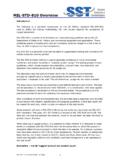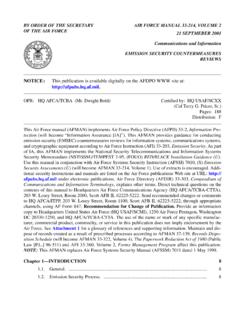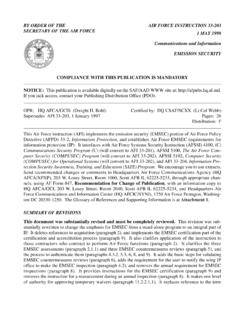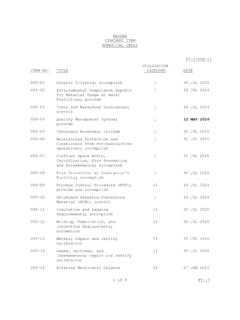Transcription of TEMPEST Introduction
1 TEMPEST Introduction SST TEMPEST Introduction iss 3 1 Introduction The following is intended as an Introduction to TEMPEST , for further details please contact Secure Systems & Technologies Ltd. What is TEMPEST ? All electrical and electronic equipment produces electromagnetic radiation (electrical emanations). The electromagnetic signals propagate through space (radiated emissions) and along electrically conductive pathways (conducted emissions). If these emissions are intercepted and analysed they could reveal that the signals contain information rather than merely noise and thus the protectively marked data could be revealed.
2 A receiving device can intercept these signals without being detected even when located some distance away, access to the original equipment is not required. Electromagnetic testing for commercial items, for instance as part of the CE compliance procedure, examines both the power of the emissions (signal strength) to ensure that it will not adversely affect other products in the locality and the tested items susceptibility to electromagnetic radiation generated from other sources to ensure it will not itself be adversely affected. TEMPEST is concerned with only the emitted radiation (both radiated and conducted) and whether the signal is information bearing.
3 TEMPEST is defined as the study of the unintentional emission of protectively marked data from an equipment or system. About SST Secure Systems & Technologies Limited (SST) specialises in the development and manufacture of electronic equipment for Military and Secure Government Organisations throughout NATO and Europe; including Ministries of Defence, Defence Prime Contractors, NATO bodies, Ministries of Foreign Affairs and other Government agencies. TEMPEST Introduction SST TEMPEST Introduction iss 3 2 A brief history of TEMPEST The ability to collect electromagnetic radiation from signal processing equipment has been known about since the 1940 s.
4 The study of emissions, the effort to secure electronic equipment and the ability to intercept and interpret those signals from other sources were brought under the codename TEMPEST . Contrary to some beliefs TEMPEST is not an acronym and does not have an actual meaning. Until relatively recently the codename TEMPEST and even the existence of the study and countermeasures was highly classified. All details of testing, signals, limits, test results and countermeasures remain protectively marked to a very high level. TEMPEST Standards The following standards are used for the specification of TEMPEST equipment.
5 Descriptive Full Intermediate Tactical SDIP-27 NATO Standard Level A Level B Level C previous NATO Laboratory test Standards AMSG-720B AMSG-788A AMSG-784 NATO Zoning Standards ZONE 0 ZONE 1 ZONE 2 USA NSTISSAM /1-92 Standards LEVEL I LEVEL II LEVEL III SST Example Products SC1000TF SC8200TF SN9200TF SN230 TIR SC8200TI SS8270TI SN790 TTR SC8338 TTRM SP280 TTR TEMPEST Introduction SST TEMPEST Introduction iss 3 3 TEMPEST Standards In addition to the previous table for TEMPEST equipment standards, the following standards are pertinent when considering installations: SDIP-27, which has replaced the AMSG-720B / AMSG-788A / AMSG-784 (NATO TEMPEST requirements and Evaluation procedures) SDIP-28, which has replaced AMSG-799 (NATO Zoning Procedures) SDIP-29, which has replaced AMSG 719 (Facility Design Criteria and Installation of Electrical Equipment for Processing Classified Information) SDIP-30 Installation of electronic equipment for processing of classified data TEMPEST equipment and installation standards detail NATO SDIP-27 Level A (formerly AMSG 720B)
6 And USA NSTISSAM Level I This is the strictest standard for devices that will be operated in NATO Zone 0 environments. TEMPEST items to this standard offer the highest level of protection. NATO SDIP-27 Level B (formerly AMSG 788A) and USA NSTISSAM Level II "Laboratory Test Standard for Protected Facility Equipment" This is a standard for devices that are operated in NATO Zone 1 environments. NATO SDIP-27 Level C (formerly AMSG 784) and USA NSTISSAM Level III "Laboratory Test Standard for Tactical Mobile Equipment/Systems" A standard for devices operated in NATO Zone 2 environments and of particular reference to mobile and installed platforms.
7 NATO SDIP-29 (formerly AMSG 719G) "Installation of Electrical Equipment for the Processing of Classified Information" This standard defines installation requirements, for example in respect to grounding and cable distances. NATO SDIP-28 (formerly AMSG 799B) "NATO Zoning Procedures" Defines a procedure according to which individual areas within a security perimeter can be classified into Zones which then determines the standard required for installed equipment. Glossary Of Acronyms TEMPEST a codeword, not an acronym! SDIP - SECAN Doctrine and Information Publication SECAN - SECurity and Evaluation Agency AMSG Allied Military Security Guide NSTISSAM - National Security Telecommunications and Information Systems Security Advisory Memorandum TEMPEST Introduction SST TEMPEST Introduction iss 3 4 SST: Maintains a CESG accredited test facility.
8 CESG is the UK National Technical Authority for Information Assurance Provides TEMPEST test facilities for products and military platforms and installations. Acts as TEMPEST authority and Subject Matter Expert for design and installation as part of larger programmes. Runs TEMPEST courses, from one-day introductions to extensive tester training and periods of hands-on practical experience. Designs and manufactures TEMPEST products. Is a division of the world s largest TEMPEST manufacturer. API Technologies Corp. is engaged as a prime system contractor in secure communications and a leading provider of electronic components and subsystems.
9









